https://sputnikglobe.com/20230325/vatican-returns-three-fragments-of-parthenon-to-greece-1108775347.html
Vatican Returns Three Fragments of Parthenon to Greece
Vatican Returns Three Fragments of Parthenon to Greece
Sputnik International
The Holy See announced the imminent return of three fragments of the Parthenon to Greece in December 2022, saying that Pope Francis made the decision after his... 25.03.2023, Sputnik International
2023-03-25T06:11+0000
2023-03-25T06:11+0000
2023-03-25T08:55+0000
world
vatican
greece
parthenon
https://cdn1.img.sputnikglobe.com/img/07e7/03/19/1108773481_0:160:3073:1888_1920x0_80_0_0_1fd6f0af36212c4db6f2fc03f86ddaba.jpg
On Friday, at a reunification ceremony in Athens, the three fragments of the Parthenon were brought to the Greek capital and its Acropolis Museum from the Vatican.The three sculptural elements were part of the decoration of the Parthenon, created by the sculptor Phidias in the mid-fifth century BC.The first piece is the head of a horse from the western pediment of the temple. The second fragment is the head of a boy, presumably holding a tray of offerings to Athena from the frieze o the temple. Another fragment is of a man's head with a beard, presumably from the south side of the same temple. The priceless marble pieces have been in Vatican museums since the 19th century.Greece has been seeking the return of what it considers illegally exported 2,500-year-old relics for decades. In 1801, agents of Thomas Bruce, 7th Earl of Elgin, removed about half of the sculptures of the Parthenon and transported them by sea to Britain, with the lord later claiming that he had obtained permission from Ottoman Porte that ruled over Greece at the time. The UK claims that the sculptures and are now legally owned by the British Museum.
vatican
greece
Sputnik International
feedback@sputniknews.com
+74956456601
MIA „Rossiya Segodnya“
2023
Sputnik International
feedback@sputniknews.com
+74956456601
MIA „Rossiya Segodnya“
News
en_EN
Sputnik International
feedback@sputniknews.com
+74956456601
MIA „Rossiya Segodnya“
Sputnik International
feedback@sputniknews.com
+74956456601
MIA „Rossiya Segodnya“
vatican, greece, parthenon
vatican, greece, parthenon
Vatican Returns Three Fragments of Parthenon to Greece
06:11 GMT 25.03.2023 (Updated: 08:55 GMT 25.03.2023) The Holy See announced the imminent return of three fragments of the Parthenon to Greece in December 2022, saying that Pope Francis made the decision after his apostolic tour of Greece and Cyprus in December 2021.
On Friday, at a reunification ceremony in Athens, the three fragments of the Parthenon were brought to the Greek capital and its Acropolis Museum from the Vatican.
"The ceremony today... similar to the gesture by the government of Sicily and the Republic of Italy a few months ago, shows the road that we could follow, that everyone could follow, in order for the unity of the Parthenon to be restored," Greece's Culture Minister Linda Mendoni said, as quoted by media.
The three sculptural elements were part of the decoration of the
Parthenon, created by the sculptor Phidias in the mid-fifth century BC.
The first piece is the head of a horse from the western pediment of the temple. The second fragment is the head of a boy, presumably holding a tray of offerings to Athena from the frieze o the temple. Another fragment is of a man's head with a beard, presumably from the south side of the same temple.
The priceless marble pieces have been in Vatican museums since the 19th century.
Greece has been seeking the return of what it considers illegally exported 2,500-year-old relics for decades. In 1801, agents of Thomas Bruce, 7th Earl of Elgin, removed about half of the sculptures of the Parthenon and transported them by sea to Britain, with the lord later claiming that he had obtained permission from Ottoman Porte that ruled over Greece at the time.
The UK claims that the sculptures and are now legally owned by the British Museum.


